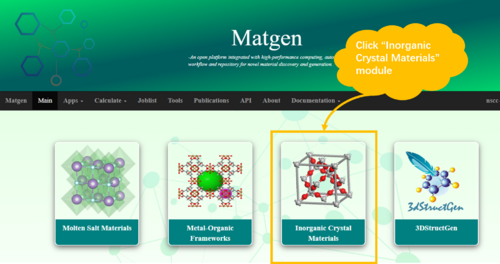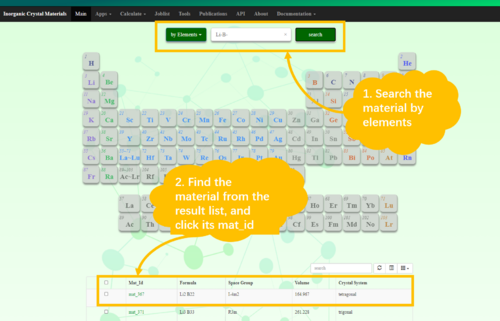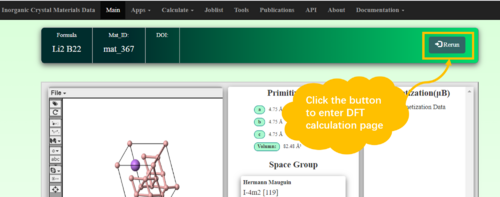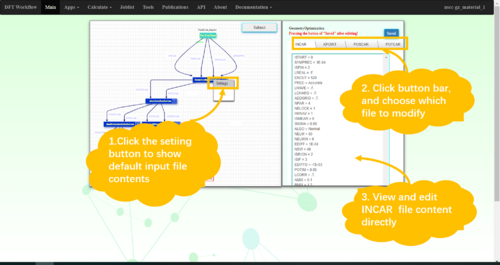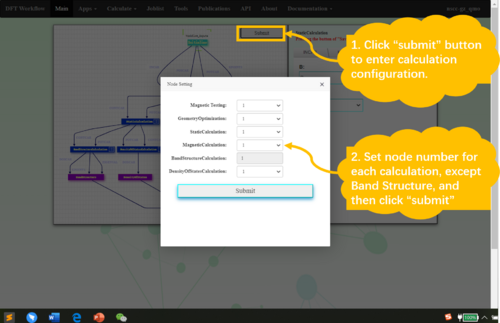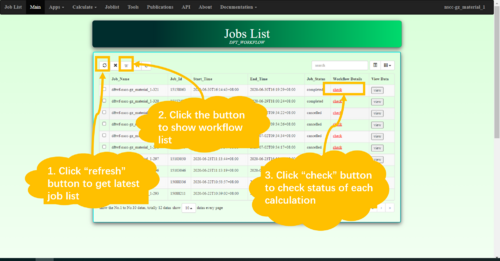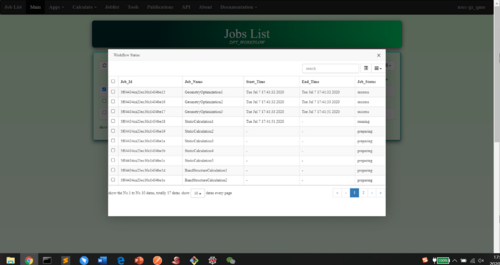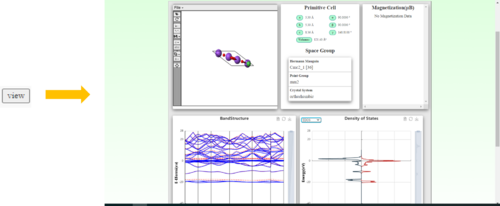Workflow Online Calculation
The Matgen platform also provides a module to run and analyze Density Functional Theory (DFT) calculations. Because the Matgen platform relies on the Tianhe-2 computing cluster to run simulation jobs, users need to log in with their Starlight account, associate their private account with a system account, and make sure they have bought computing resources on the Tianhe-2c WORK cluster before running DFT calculations. Currently, the Matgen platform only supports DFT calculations running with the Vienna Ab initio Simulation Package (VASP), and users also need to have a valid VASP license. Please click [[here|log in] to log in. Please click here to associate your account with the system account.
This module mainly supports workflow design, workflow submission, workflow status monitoring, analyzed data visualization, and workflow cancellation.
Choose System for DFT calculations
To run a DFT simulation for a particular system, you can enter this module through the “Inorganic Crystal Materials” module on the main page, then search and choose the material for your DFT calculations.
Pic 1 Enter “Inorganic Crystal Materials” module
Pic 2 Search the target material and enter material detail page
Pic 3 Enter DFT calculation page: click “RERUN
Workflow Design
The Matgen platform provides a whole workflow, including Magnetic Testing, Geometry Optimization, Static Calculation, Band Structure Calculation, Density of States Calculation, and Magnetic Calculation. You can choose the calculations above to run and modify your Input Files for each calculation.
Calculation Process Design
If you don't need to run all of the calculations, you can choose parts of properties for simulation by clicking the name of calculations you don’t need and delete it.
Pic 4 Delete “Magnetic Testing”: click “Magnetic Testing”; click “delete”
Input Parameter Setting
The VASP has four kinds of input files, INCAR, KPOINTS, POSCAR, and POTCAR. For INCAR, KPOINTS, and POSCAR, the Matgen platform provides default content so that the VASP calculation result can be more physically meaningful. You can adjust file content directly by choosing calculation, clicking the file name you want to edit, and modifying content on the right side. For POTCAR, because the POTCAR file can generate by combining each element of other POTCAR files in the system, you can modify the pseudopotential of each element instead of editing the whole POTCAR file.
Pic 5 Edit “Geometry Optimization” input files: click “Geometry Optimization”; click “Settings”; click the file to modify; modify directly
Calculation Configuration Setting
For high-throughput jobs, you need to set calculation configurations manually to run the VASP better. The main configuration is the node number. In the Matgen platform, you can choose node numbers less than 4 for each calculation except Band Structure Calculation.
Pic 6 Set node number for each calculation: click “submit” button after editing input files; click “submit”; choose node number for each calculation; click submit to submit workflow
Workflow Status Monitoring
After workflow submission, you will enter the job list page, and you can check the workflow status and the status of each step.
Pic 7 Get status of each calculation in a workflow: click “refresh” button; click “W” button; click “check” button
Pic 8 Status of each calculation in a workflow
Data Visualization
If one of the calculations in a workflow is finished without error, you can see processed results in the job lists by clicking the "view" button.
Pic 9 Get data after workflow calculation: click “view” button in job lists
Workflow Cancellation
If you want to cancel a running workflow, you can select the specific workflow from the job list and cancel it.
Pic 10 Cancel workflow: select from job list; click “X” button
